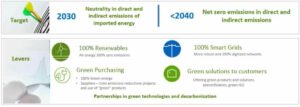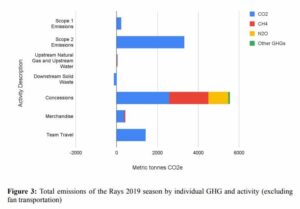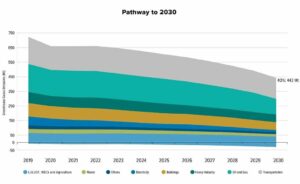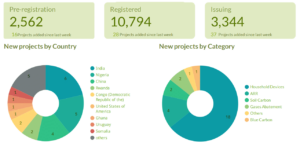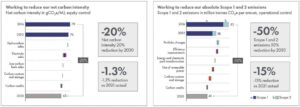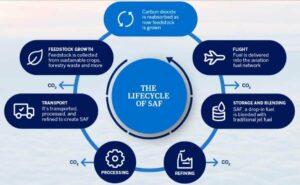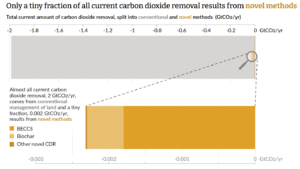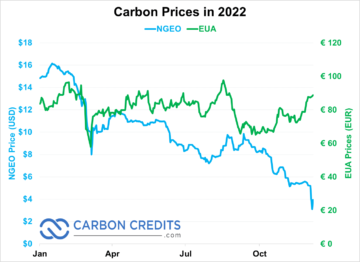The Canadian government is taking steps to greenhouse gas emissions, especially from cows’ burps, a significant source of methane. Environment and Climate Change Canada (ECCC) is proposing incentives for beef cattle farmers to lower methane emissions by improving diets and management practices.
The proposal, Reducing Enteric Methane Emissions from Beef Cattle (REME), introduces offset credits for each tonne of reduced emissions. Farmers can then sell these credits to industries aiming to cut their carbon footprint.
This initiative encourages changes in cattle diets, feed efficiency improvements, and strategies that minimize methane release.
The Farmers’ Battle: Cutting Cow Burps
Government spokesperson Oliver Anderson highlighted the aim to reward farmers using feed additives to diminish cow-produced methane. He noted farmers’ previous contributions in lowering methane per unit of milk through improved livestock genetics.
The proposed eligible activities include altering cattle diets, adding specific ingredients to boost animal performance, and employing growth promoters. Tim McAllister from Agriculture and Agri-Food Canada suggested that modifying cattle diets, like adding grain and oil, could help cut methane emissions while improving feed efficiency for meat production.
ECCC Minister, Steven Guilbeault, also noted farmers have been the champions of climate action through sustainable agricultural practices. He further added that:
“This [draft protocol] is an opportunity for farmers to implement practical solutions to reduce agricultural methane emissions, generate revenue, and harvest a greener future for all.”
In 2021, agriculture accounted for 31% of Canada’s total methane emissions, primarily from enteric fermentation in beef and dairy cattle. Enteric fermentation is a digestive process that generates methane. Methane is released when cows burp as part of their natural digestion.
According to the American Society for Microbiology, enteric fermentation is responsible for 27% of global methane emissions in 2020.
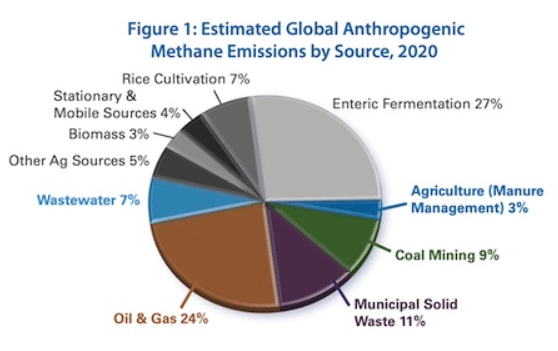

The Math Behind Cows’ Methane Emissions
Cows, through the process of digestion, contribute significantly to methane emissions.
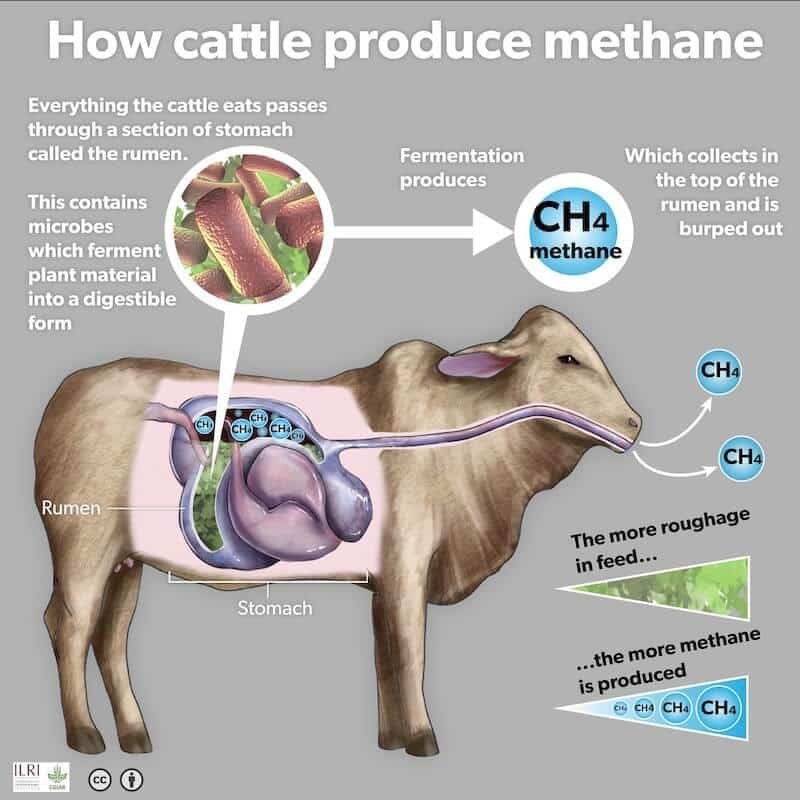

According to research, an average amount of methane produced by 2 cows a year is 504 pounds. In comparison, one car emits around 11,500 pounds of carbon dioxide.
To put that in context, methane is 28x more potent than CO2 at trapping heat in the atmosphere. That means, each year, two cows release as much GHG as one car driven 10,000 miles.
In Canada, it accounts for about 45% of total agricultural emissions.
Methane, responsible for around 13% of the country’s overall GHG emissions in 2021, primarily comes from three sources:
- Oil and gas (38%),
- Agriculture (30%), and
- Waste or landfills (28%).
The majority (96%) of methane emissions from enteric fermentation come from cattle. While various animals can release methane through digestion, cattle are the primary source in the country.
The Canadian government further aims to reduce nitrous oxide emissions, another GHG originating from manure or animal feed.
To address methane emissions, the REME proposes incentives for farmers to adjust cattle diets, manage feed consumption, and reduce emissions.
These measures will be further refined based on stakeholders feedback before a final version is released in the coming summer. Agricultural practices will be adjusted to balance nutrient needs while minimizing the cost of implementing changes.
Additionally, Canada is targeting methane reductions in the oil and gas sector, aiming for a 75% reduction according to a newly released draft plan by the ECCC.
These regulations aim to reduce emissions by 217 megatonnes (CO2 equivalent) from 2027-2040. This would result in social and economic benefits totaling $12.4 billion from avoided global damages.
REME: Canada’s Emission Reduction Plan
The Government of Canada developed the REME protocol in collaboration with agricultural experts. Their goal is to ensure it offers practical ways for farmers to earn revenue through emissions reductions.
REME is ECCC’s draft fourth protocol under Canada’s Greenhouse Gas (GHG) Offset Credit System. The system encourages project developers to create innovative projects that reduce GHGs compared to business-as-usual practices.
Proponents of offset projects can produce carbon credits if their projects meet the requirements of the Canadian GHG Offset Credit System Regulations and an applicable federal offset protocol.
The REME protocol draws on input from technical experts and incorporates best practices from provinces like Alberta. It is also part of Canada’s comprehensive efforts to decarbonize the agricultural sector.
For instance, the Agriculture and Agri-Food Canada announced investment of $12 million in the Agricultural Methane Reduction Challenge. This funding aims to support innovators in developing cost-effective and scalable solutions to reduce enteric methane emissions from cattle.
Canada is steering towards a greener agricultural future by addressing methane emissions from beef cattle. The REME initiative reflects the government’s commitment to incentivize emissions reductions and empower farmers in mitigating climate change. Through these innovations, the country aims to provide sustainable solutions while aligning with global climate goals.
- SEO Powered Content & PR Distribution. Get Amplified Today.
- PlatoData.Network Vertical Generative Ai. Empower Yourself. Access Here.
- PlatoAiStream. Web3 Intelligence. Knowledge Amplified. Access Here.
- PlatoESG. Carbon, CleanTech, Energy, Environment, Solar, Waste Management. Access Here.
- PlatoHealth. Biotech and Clinical Trials Intelligence. Access Here.
- Source: https://carboncredits.com/greening-the-pasture-canadas-plan-to-curb-methane-emissions-from-cattle-burps/
- :is
- 000
- 1
- 10
- 11
- 2020
- 2021
- 500
- a
- About
- According
- accounted
- Accounts
- Action
- activities
- added
- adding
- additives
- address
- addressing
- adjust
- Adjusted
- Agricultural
- agriculture
- aim
- Aiming
- aims
- aligning
- All
- also
- American
- amount
- an
- and
- anderson
- animal
- animals
- announced
- Another
- applicable
- ARE
- around
- AS
- At
- Atmosphere
- average
- avoided
- Balance
- based
- Battle
- BE
- Beef
- been
- before
- behind
- benefits
- BEST
- best practices
- boost
- by
- CAN
- Canada
- Canadian
- car
- carbon
- carbon dioxide
- carbon footprint
- cattle
- challenge
- Champions
- change
- Changes
- Climate
- climate action
- Climate change
- co2
- collaboration
- come
- comes
- coming
- commitment
- compared
- comparison
- comprehensive
- consumption
- context
- contribute
- contributions
- Cost
- cost-effective
- could
- country
- country’s
- create
- credit
- credit system
- Credits
- Cut
- cutting
- dairy
- data
- decarbonize
- developed
- developers
- developing
- draft
- draws
- driven
- each
- earn
- Economic
- efficiency
- efforts
- eligible
- emission
- Emissions
- employing
- empower
- encourages
- ensure
- Environment
- Equivalent
- especially
- experts
- farmers
- Federal
- feedback
- final
- Footprint
- For
- Fourth
- from
- funding
- further
- future
- GAS
- generate
- generates
- Genetics
- GHG
- GHG emissions
- Global
- goal
- Goals
- Government
- greener
- greenhouse gas
- Greenhouse gas emissions
- Growth
- harvest
- Have
- he
- help
- Highlighted
- How
- HTML
- http
- HTTPS
- if
- implement
- implementing
- improved
- improvements
- improving
- in
- Incentives
- incentivize
- include
- incorporates
- industries
- ingredients
- Initiative
- innovations
- innovative
- innovators
- input
- instance
- Introduces
- investment
- IT
- jpg
- like
- lower
- lowering
- Majority
- manage
- management
- math
- max-width
- means
- measures
- Meat
- Meet
- methane
- methane emissions
- Milk
- million
- minimize
- minimizing
- minister
- mitigating
- more
- much
- Natural
- needs
- newly
- noted
- of
- Offers
- offset
- Oil
- oliver
- on
- ONE
- Opportunity
- or
- originating
- overall
- part
- per
- performance
- plan
- plato
- Plato Data Intelligence
- PlatoData
- potent
- pounds
- Practical
- practices
- previous
- primarily
- primary
- process
- produce
- Produced
- Production
- project
- projects
- promoters
- proposal
- proposed
- proposes
- proposing
- protocol
- provide
- provinces
- put
- reduce
- Reduced
- reduction
- reductions
- refined
- reflects
- regulations
- release
- released
- Requirements
- research
- responsible
- result
- revenue
- Reward
- scalable
- sector
- sell
- significant
- significantly
- Social
- Society
- Solutions
- Source
- Sources
- specific
- spokesperson
- stakeholders
- steering
- Steps
- steven
- strategies
- summer
- support
- sustainable
- system
- taking
- targeting
- Technical
- than
- that
- The
- their
- then
- These
- this
- three
- Through
- Tim
- to
- Total
- towards
- trapping
- two
- under
- unit
- using
- various
- version
- W3
- ways
- webp
- when
- while
- will
- with
- would
- year
- zephyrnet



